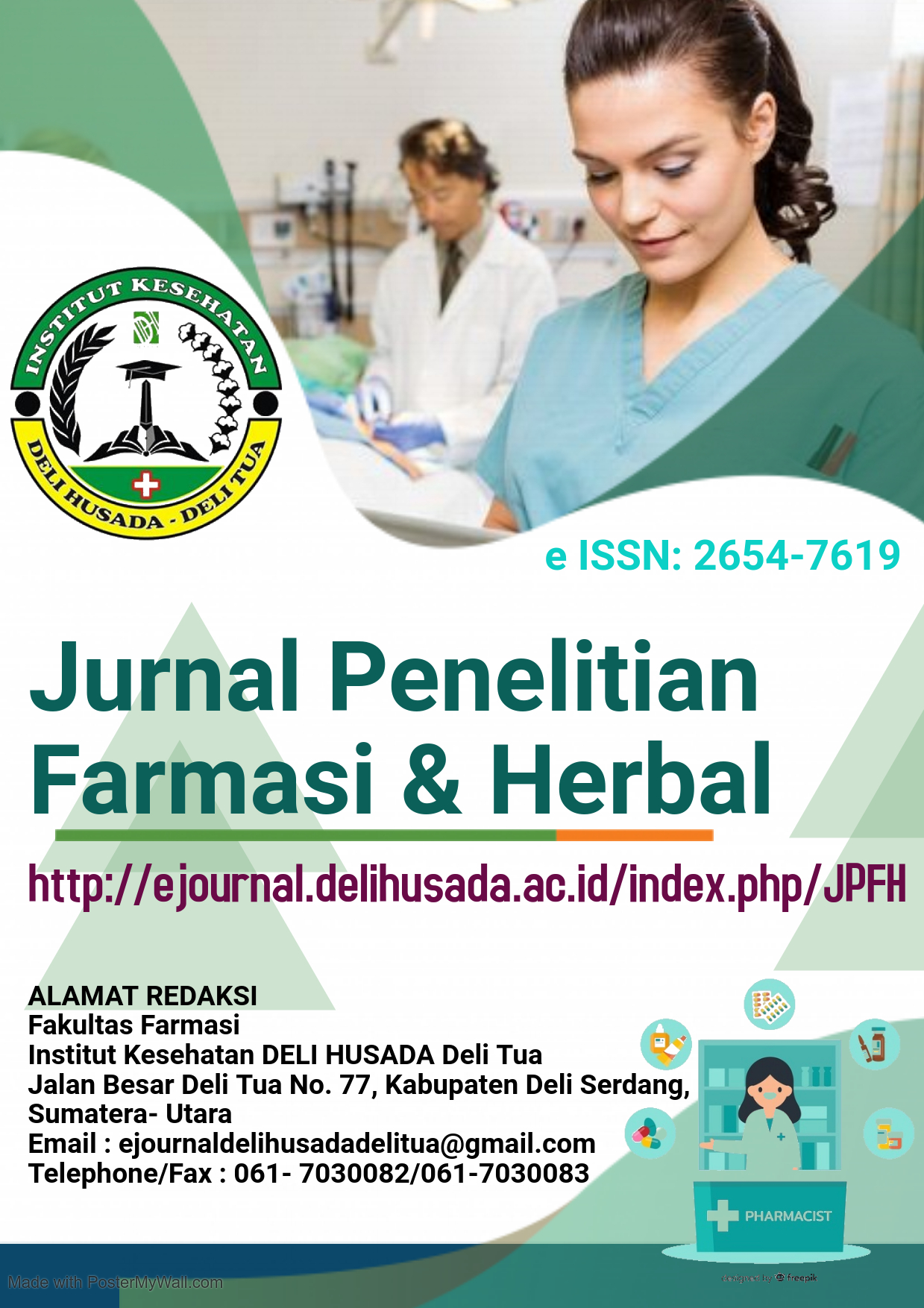“UJI EFEKTIVITAS FORMULASI EKSTRAK ETANOL BUAH PARE (Momordica charantia L.) DENGAN DAUN PEPAYA (Carica Papaya L.) SEBAGAI LOTION AEDES AEGYPTI”
Abstract
Flaviviridae, genus Flavivirus, and group of arthropod-borne viruses. Aedes mosquitoes, particularly Aedes aegypti or Aedes albopictus, are the primary vectors of dengue disease transmission. A product that is used in skin-protection cosmetics to protect the skin from mosquito bites is anti-mosquito lotion (repellent). Water, emulsifying agents, humectants, and fatty ingredients make up lotion preparations. The bitter gourd and papaya leaves employed in this study were the active ingredients used to make lotion preparations. The lotion formulation used in this investigation contained flavonoid chemicals at varied extract concentrations of 0%, 2%, 4%, and 6%. The bitter gourd's and leaves' active components Because papaya is known to contain a lot of antioxidants, it can be used as an insecticide and lotion to ward against mosquitoes. According to SNI-16-4399-1996, preparations for anti-mosquito lotion made from papaya leaves and bitter melon extract pass the physical quality test because they are all homogeneous, have an oil-in-water emulsion type, are stable during storage for two weeks, and do not irritate the skin. Anti-mosquito lotion made with bitter melon fruit extract and papaya leaves, which is distinguished by the presence of dead mosquitoes in each formulation, has an effect on the effectiveness as an insecticide or repellent against mosquitoes on the skin that is applied. The extract lotion preparations' concentration The most powerful insecticide or mosquito repellant is a 6% extract of bitter gourd fruit and papaya leaves.
Downloads
References
Agustiina. (2017). Kajiian Karakteriisasii Tanaman Pepaya (Cariica papaya L.) Dii Kota Madya Bandar Lampung. Skriipsii. Lampung : Fakultas Matematiika dan Ilmu Pengetahuan Alam Uniiversiitas Lampung.
Dheasabel, G., & Aziinar, M. ( 2018). Kemampuan Ekstrak Buah Pare Terhadap Kematiian Nyamuk Aedes aegyptii. Jurnal Hiigeiia 2(2) : 331-341.
Domiiniica, D., Handayanii, D., S-farmasii, P., Matematiika, F., Alam, P., & Bengkulu, U. (2019). Jurnal Farmasii dan Ilmu Kefarmasiian Indonesiia Vol. 6 No. 1 Julii 2019 1. 6(1), 1–7.
Fauzii, A. R., & Nurmaliina, R. (2012). Merawat Kuliit dan Wajah. Jakarta: PT Elex Mediia Komputiindo.
Hadiinegoro. 2013. Demam berdarah Dengue. 2013: balaii Penerbiit Kedokteran Uniiversiitas Indonesiia
Kemenkes RI. Pedoman Pengendaliian Demam Berdarah Dengue Dii Indonesiia Jakarta: Diirjen PP&PL ;2013.
Melawatii oliiviia niingrum, S. M. (2018). Studii Formulasii Sediiaan Lotiion Antii Nyamuk Oleum Ciitronella. J-PhAm Journal of Pharmaceutiical Care Anwar Mediika .Departemen Kesehatan Republiik Indonesiia, 2000, Parameter Standar Umum Ekstrak Tumbuhan Obat, Departemen Kesehatan Republiik Indonesiia, Jakarta, Indonesiia
Nadiifah, F. dkk. 2016. Identiifiikasii Larva Nyamuk pada Tempat Penampungan Aiir dii Padukuhan Dero Condong Catur Kabupaten Sleman. Jurnal Kesehatan Masyarakat Andalas, 10(2). http://jurnal.fkm.unand.ac.iid (Diiakses: 21 November 2019).
Permana, I. S., & Sumaryana, Y. (2018). Siistem Pakar Untuk Mendiiagnosa Penyakiit Kuliit Dengan Metode Forward Chaiiniing. Jurnal Manajemen dan Tekniik Informatiika (JUMANTAKA), 1(1).
Prakoso, G., Aulung, A., & Ciitrawatii, M. (2016). Ujii Efektiiviitas Ekstrak Buah Pare (Momordiica charantiia) Pada Mortaliitas Larva Aedes aegyptii. Jurnal Profesii Mediika. 10(1) ; 46-53.
Sapta Permana, I., & Sumaryana, Y. (2018). SISTEM PAKAR UNTUK MENDIAGNOSA PENYAKIT KULIT DENGAN METODE FORWARD CHAINING.
Soedarto. 2012. Demam Berdarah Dengue Dengue Haemoohagiic fever. Jakarta: Sugeng Seto.
Suliihandrii, H. 2013. Herbal, Sayur & Buah Ajaiib : Koleksii Bahan Alamii nan Ajaiib untuk Hiidup jauh darii penyakiit. Yogyakarta: Trans Idea Publiishiing.
Wardiina RF. Potensii Perasan Daun Pepaya (Cariica papaya L.) Terhadap Jumlah Makrofag Giingiivektomii Pada Tiikus Wiista Jantan. Jember: Uniiversiitas Jember; 2012







